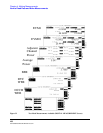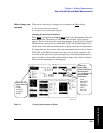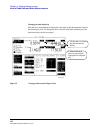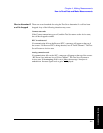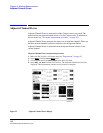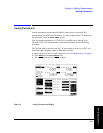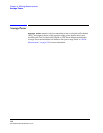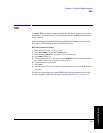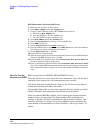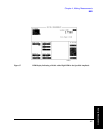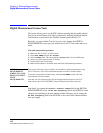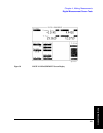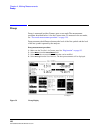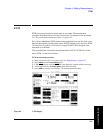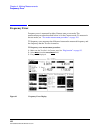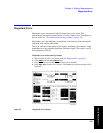
116
S:\HP83206A\USRGUIDE\MANUAL\meas.fm
Chapter 4, Making Measurements
BER
BER Measurement with Inserted Bit Errors
1. Make sure the Test Set is in Active mode.
2. Select
CALL CNFG
from the
To Screen
menu.
3. Assign a global USER key to the % BIT ERROR field as follows:
a Select the
% BIT ERROR
field.
b Press the SHIFT key, then k4 (ASSIGN) key.
c Press the SHIFT key again, then the k1 key.
4. Select
DIG MEAS
from the
To Screen
menu.
5. Select the
Dig Meas
field to display a list of available tests.
6. Select
BER
from the list.
7. Set the
Single/Cont
field to
Cont
(continuous).
8. Enter the number of bits to be measured in the
BER Bits
field. (Note: the number of
bits actually read will be calculated in whole frames.)
9. Set the
Amplitude
field to
−
50 dBm.
10. Put the mobile in loopback mode.
11. After the actual number of bits has been transmitted and received, the BER should be
displayed. The BER should be 0% at
−
50 dBm.
12. Press the SHIFT key then the k1 key. The
Inserted DTC Bit Error Rate
field
should be displayed at the top of the screen.
13. Enter a value between 0.00% and 20.00% in the
Inserted DTC Bit Error Rate
field. The Loopback BER measurement should return the value that you entered in this
field. If this measurement is slightly off, increase the number of BER bits to 50,000 or
more.
How the Test Set
measures raw BER
BER is measured in the DIGITAL MEASUREMENT screen.
When the Test Set is in Active state (the Active annunciator is on), the Test Set is
emulating a base station, but is not communicating with a mobile.
The mobile must be in loopback mode. That way, the Test Set receives the data
without the data being decoded by the mobile.
Selecting Dig Meas while in Active state signals the Test Set to bring up a traffic
channel. The data is then transmitted and received over that channel.
When you enter the BER Bits number, you are selecting the desired maximum
number of bits to be transmitted. The actual number of bits transmitted is a
multiple of 260 bits. The data is transmitted in a whole number of frames. One
frame has 260 bits. For example, if you select 10000 bits to be transmitted, the
actual number of bits transmitted is 10140 (10140 bits / 260 bits per frame = 39
frames).



